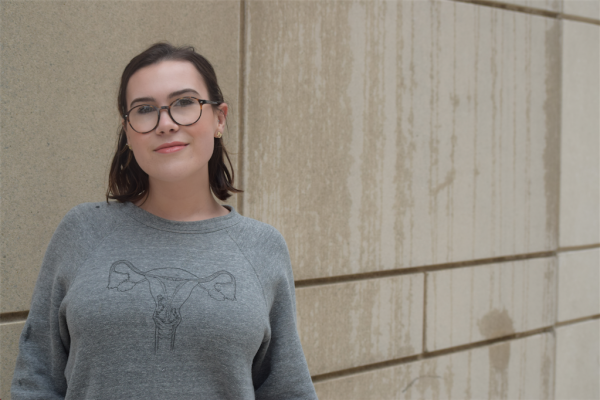Rachel Antonoff: Reclaiming the Uterus
Rachel Antonoff’s signature design is the “Randy Sweater,” which features a uterus on the front. (JON BJÖRNSON/THE OBSERVER)
March 14, 2018
People cannot identify a uterus when they see one. Or at least that was the discussion topic on a Friday afternoon during my internship at the Rachel Antonoff studio, a small, two-story loft with floor-to-ceiling windows located in the heart of the Garment District. Antonoff and co-designer Hannah Mosman sit upstairs at large pink painted tables, where they find inspiration for new collections, sketch designs and discuss current events. It’s hard not to listen in—they are two of the coolest and most insightful women I have ever met.
The uterus is Antonoff’s signature design. The “Randy Sweater,” which features a two-toned uterus on the front, is the piece that introduced me to the brand several years ago. The sweater, like many of Antonoff’s designs, fosters a sense of women’s empowerment and awareness. On top of that, but a portion of the proceeds from the Randy Sweater goes to Planned Parenthood. In wearing the sweater, one evokes an important message: I am proud to be a female and I support women; I care about my reproductive health and making sure all women have access to care.
At first, I did not think it was possible that the average person could not recognize the shape of half the population’s reproductive system. The first article of clothing I purchased was the “Reproductive Sweatshirt,” which features an illustration of a uterus. After my order came in the mail I wore my sweatshirt everywhere I went. I finally understood. My female cousin thought it was a flower, while others thought it was a map or abstract art. My sister, on the other hand, could name every tube, which made me realize how little I knew about my own body. It was only after the purchase that I became fully aware of the vital structures inside me.
I interned with Antonoff in the fall 2017 semester. On the first day of my internship, I was greeted by a group of women seated around a conference table. They were all wearing white t-shirts which read “Hysterical Female” across the front in bold black letters. The extremely soft, cotton blend tee is a reclamation: the word “hysterical” has had connotations of diminishing and silencing women for being “emotional,” and blames their emotions on gender. In early summer 2017, a member of the Trump administration’s personnel used the term “hysterical” to describe female Senator Kirsten Powers.
A year earlier, Antonoff made her mark in the 2016 Presidential Election with the release of t-shirts and sweatshirts that read “I’m With Her!,” “Not With Him!” and “I’m With Human!” Regarding the inspiration behind her designs, Antonoff remarked, “It was never a conscious decision to politicize the clothing. The line has always been an extension of myself and my thoughts and feelings, so when we started doing t-shirts with slogans on them, politically-inclined statements naturally made their way in.”
Antonoff utilizes her Instagram, @rachelantonoff, as a platform for political change in America. She asks her followers to support other Instagrams that promote gun safety, such as @everytown and encourages people to reach out to Senators to show discontent for health care bills by providing access to telephone numbers. She re-posts pictures of people wearing her clothing to create a sense of community. Additionally, the brand is as inclusive as it is politically-inclined. Antonoff hires models of color and plus size models for all of her collections’ photoshoots.
Antonoff has created a trend of making statements through clothing. Large companies such as Urban Outfitters have produced graphic tees with feminist slogans such as “Impress No One” and “Keep Your Laws Off My Body.” In my four months interning at Antonoff, I was able to see the process of making garments from start to finish, and the impeccable attention to detail that goes into to making politically-inclined fashion. I was able to witness business meetings and experience the power that is derived from an all-female office. I learned about fabrics I cannot pronounce and how much work there still needs to be done in the fight for equality. Antonoff’s clothing is revolutionary: it speaks for itself and asks critical questions of the people who come into contact with it. Can you identify a uterus?










